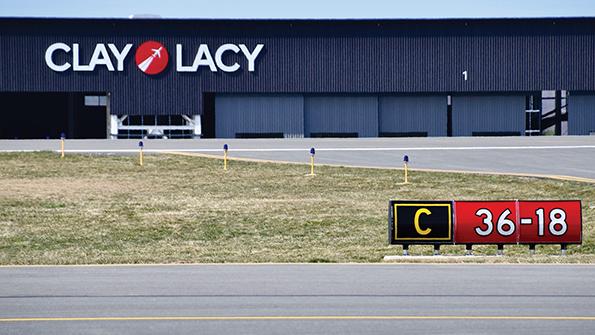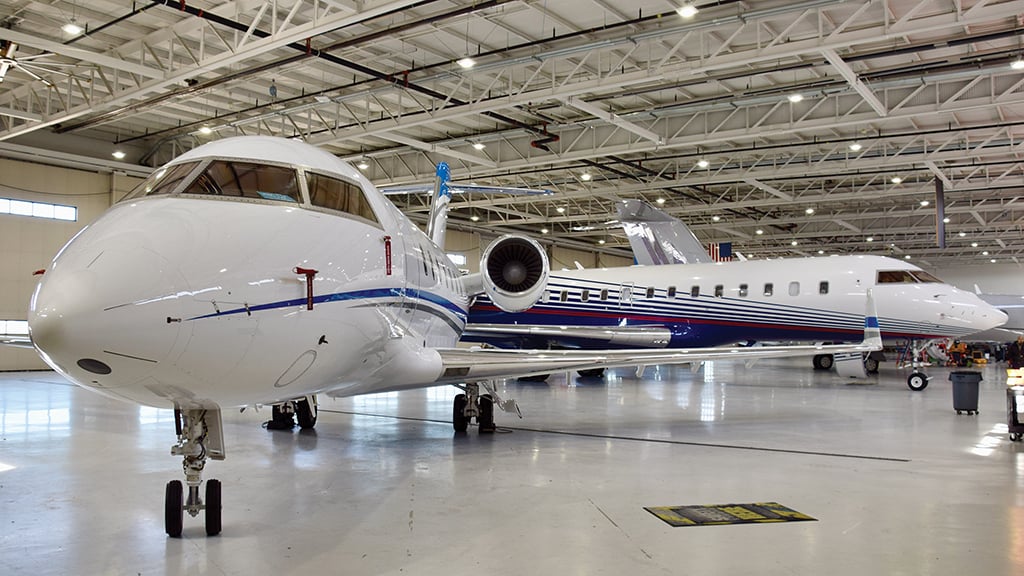
The new Clay Lacy Aviation hangar facility overlooks Runway 18/36 at Waterbury-Oxford Airport in Connecticut.
Clay Lacy Aviation will have a larger presence in the U.S. northeast region this summer—literally. The Los Angeles-based private aviation services company plans to open a new, 120,000-ft.2 corporate hangar facility with an additional fixed-base operator (FBO) terminal at Waterbury-Oxford Airport (KOXC) in southwestern Connecticut, just a 20-min. to 30-min. flight to New York metropolitan area airports.
Clay Lacy Aviation already provides aircraft management, charter and MRO services at KOXC, where it put down roots in 2015 with the acquisition of the former Key Air. The massive new hangar, office and FBO building raises its profile considerably.
“The East Coast has a huge deficit for hangar space,” says David “Buddy” Blackburn, Clay Lacy Aviation senior vice president, KOXC FBO. “There’s not a lot of airports you can build on. We had the ability to build here. The demand was strong—it still is.”

Blackburn, who is overseeing the development, construction and operation of the new facility, was working from a construction trailer at the foot of the building when BCA visited in late March. This is not his first rodeo: Blackburn has overseen the addition of 295,000 ft.2 of hangar and office space at KOXC since arriving there in 1990, originally with Keystone Aviation Services, then Atlantic Aviation and, since 2021, Clay Lacy Aviation. Nevertheless, this is his largest, career-crowning project.
Clay Lacy Aviation broke ground on what was described as one of the largest private investments in Connecticut’s general aviation airport system in August 2022. The plan was to open the facility in phases, starting with a $20 million outlay for the passenger terminal, offices and 40,000 ft.2 of hangar space. Since breaking ground, the company has decided to build out the entire facility, a $42 million investment.
The first third of new hangar space was sold out by August 2023, Clay Lacy Aviation says. As of March this year, about 65%-70% of the entire facility was spoken for, according to Blackburn. “Originally it was going to be phased, but the demand is such that we kept going,” he says. “We are going to build it all.”
In addition to its proximity to New York City, KOXC has a higher availability of hangar space—nowadays a precious commodity—compared to metro airports, at 30% lower rental rates, Clay Lacy Aviation says. The airport has an instrument landing system, an FAA contract tower and a 5,801-ft.-long runway capable of handling the latest large-cabin business jets. The surrounding area is less congested than the metropolis to the south and affordable for corporate pilots seeking a place to live.
Atlantic Aviation, the resident FBO, and the Connecticut Airport Authority funded the establishment of a U.S. Customs and Border Protection facility at KOXC that opened in 2022. Atlantic Aviation also leases office and hangar space to Clay Lacy Aviation for its MRO business at the airport.
Designed For The Latest Bizjets
The new hangar building “was conceived, designed and built with today’s largest and most modern business jets in mind,” Clay Lacy Aviation says, naming the Bombardier Global 7500, the Dassault Falcon 10X and the Gulfstream G700.
Located at the northwest corner of the airport, the building fronts on a taxilane that leads to Runway 18/36. The facility consists of three 40,000-ft.2 hangars, each with two aircraft bays, or six bays total. Hangar doors are 29 ft. high—one foot more than typical—which provides better clearance for larger jets during snow or inclement weather, Blackburn explains. Clay Lacy Aviation was granted a variance to install a wet sprinkler system for fire suppression, preventing the possibility of damage to aircraft from deluge foam systems.
A ground-level entryway with nearby covered parking leads to the three-level FBO terminal and office facility, a “building within a building” situated between two of the hangars that includes pilot and conference rooms. In addition to hangar space, operators can rent from 500 ft.2 to 2,000 ft.2 of customizable office space.
Clay Lacy Aviation says all facilities are being built in accordance with its sustainability strategy. All lighting is the more efficient LED variety, and the hangar facility has double the fiberglass insulation by code, Blackburn says. Among other features, the roof of the structure is being provisioned for solar panels.
The site is also provisioned to support future electric vertical-takeoff-and-landing (eVTOL) aircraft. In January, Clay Lacy Aviation announced partnerships with eVTOL air taxi developers Overair and Joby Aviation to install electric chargers at its southern California airport locations. KOXC also figures in its advanced air mobility strategy.
“We have the infrastructure,” says Blackburn, who describes the electrical system layout. “I have conduit coming from a telephone poll underground to a pad that has the transformer for our building now, and there is a separate empty pad for another transformer in case we need more power for eVTOLs. And I have conduit that goes from that pad into our building, which goes through into a chase, that goes up into a hangar. We’re going to run the line inside the hangar out to the [taxilane] and have eVTOL plug-ins right there.”
An early adopter of sustainable aviation fuel (SAF), Clay Lacy Aviation announced a partnership with World Fuel Services to offer SAF at its Van Nuys Airport and John Wayne Orange County Airport FBOs in California in early 2021. The provision of sustainably sourced Jet-A, as well as a future unleaded avgas for piston-engine airplanes, is planned for KOXC, as well, Blackburn affirms. The company’s new facility will have 40,000 gal. of storage capacity and two 5,000-gal. Jet-A refuelers to service aircraft.





